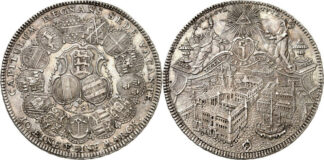A New Dimension: Record Results at Heidelberger Münzhandlung’s Auction Sale
If you go to CoinArchives today and search for the most expensive Nuremberg talers, you’ll think at first that you made a typo because the six most expensive pieces were all sold at the same auction, they were part of the Nuremberg Special Collection auctioned off on 11 November 2020 in Heidelberg by Heidelberger Münzhandlung, Herbert Grün e. K. In other words, prices of Nuremberg issues reached a new dimension, and that does not only apply to Nuremberg talers: the most expensive Nuremberg pfennig was sold at the same auction, and Herbert Grün almost set a new record for the most expensive Nuremberg gold gulden.
On the same day, Heidelberger Münzhandlung sold a comprehensive collection of German talers, double guldens and double talers from the time between 1800 and 1872. And the auction house set new records in this area, too: the most expensive silver coin of the Kingdom of Westphalia, for example.
The high price level is especially remarkable because this was the first time that Heidelberger Münzhandlung didn’t run a public auction but held the sale via live bidding. This demonstrates that many digital auctions now achieve results that are just as impressive, if not more impressive than those of public auctions. And by now everyone knows that the coin trade is booming due to Covid-19. So, if you want your collection to achieve the best possible result, you should sell it now.
In this review, we present the highest results of both special collections sold at Heidelberger Münzhandlung’s auction 80, the most expensive Nuremberg taler, the most expensive Nuremberg double taler, the most expensive Nuremberg gulden taler, the most expensive Nuremberg pfennig and the second most expensive Nuremberg gold gulden. Then we will take a look at the top five results achieved in the sale of German talers, double guldens and double talers.

The Most Expensive Nuremberg Taler
The taler which sold for 18,000 euros and was therefore adorned with the title of the most expensive Nuremberg taler was minted in 1628. The piece features Ferdinand II as emperor in full regalia with sceptre and imperial crown at the peak of his power. He sits on a horse, which is wearing splendid decoration. The coin was created in the year in which the imperial troops defeated the Danish king, who had tried to intervene in the Thirty Years’ War on the side of the Protestants. On the reverse, a small, winged genius presents both coats of arms of Nuremberg.
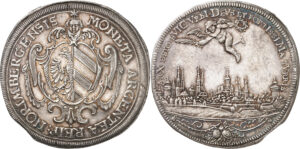
The fact that the result of the above-mentioned taler wasn’t pure coincidence is proven by the amount paid for the second most expensive taler of that very auction – it sold for only 1,000 euros less, i.e. for a hammer price of 17,000 euros. The extremely rare piece features a wonderful city view and was minted in 1635.
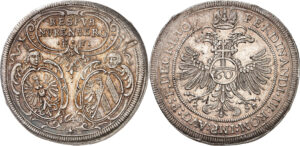
The Most Expensive Nuremberg Gulden Taler
The most expensive gulden taler of 60 kreuzers sold for more than three times its estimate, i.e. for 15,500 euros. The rare piece, which is missing in the Erlanger Collection, stands out because of its wonderful condition and excellent striking quality. On one side it features a cartouche with the name of the city of Nuremberg, below it, two genii are holding the city’s two coats of arms. We can see the imperial eagle on the other side, an orb on its chest with the number 60 indicates that this is a gulden taler of 60 kreuzers.
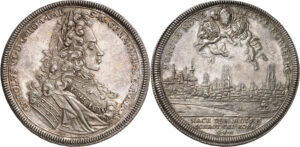
The Most Expensive Nuremberg Double Taler
The most expensive Nuremberg double taler was made in 1711. The obverse depicts a magnificent baroque bust of Emperor Charles VI, the father of Maria Theresa. The reverse features a wonderful city view, above it, three genii playfully hold up both coats of arms of Nuremberg and the two-headed eagle representing the Holy Roman Empire. The piece jumped from an estimate of 8,000 euros to a hammer price of 16,000 euros.

The Most Expensive Nuremberg Pfennig
Who says that record prices always have to be in the five-digit range? This small, insignificant pfennig from 1615, a one-side issue featuring both coats of arms with the year on the engraved side, was sold for 310 euros – an impressive result, almost four times its estimate. Although Nuremberg pfennigs of average quality are so common that they are usually sold in multiple lots, it is very difficult to find pieces – especially from rare years of issue such as 1615 – of perfect quality.

The Auction’s Most Expensive Nuremberg Gold Gulden
The most expensive Nuremberg gold gulden of this auction sale achieved a hammer price of 11,750 euros, which is only 250 euros less than the amount for which the most expensive Nuremberg gold gulden was sold in February 2016. The piece offered at Grün features an outstanding portrait of Emperor Rudolf II on the obverse, and Nuremberg’s two coats of arms on the reverse.
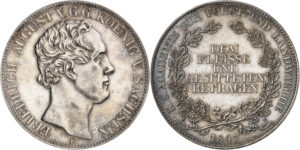
The Top Five German Talers, Double Guldens and Double Talers from 1800 to 1872
And this brings us to the five most expensive coins of the second part of Heidelberger Münzhandlung’s auction sale containing German talers, double guldens and double talers struck between 1800 and 1872.
The 5th place was taken by a Saxon rarity, a double taler of which only 50 specimens were minted as awards for particularly outstanding graduates of the Academy of Forestry in Tharandt.
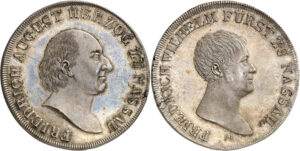
The konventionsthaler of 1815 was sold for its exact estimate of 35,000 euros. The issue depicts Frederick August, the ruling Duke of Nassau, and Frederick William, his heir to the throne, on the occasion of a joint visit of the mint of Ehrenbreitstein. Therefore, it took fourth place in the Top 5 of this special collection.

A hammer price of 40,000 euros made this konventionsthaler of the King of Westphalia by the grace of Napoleon, Hieronymus, the third most expensive piece of the collection and the most expensive silver coin of the Kingdom of Westphalia. On the obverse, the coin features the Order of the Crown of Westphalia founded by Jerome Bonaparte on the left, and the Order of the Legion of Honour founded by his brother, the emperor, on the right.

Specimens of the first taler minted by Frederick I after his elevation to the throne of outstanding quality always achieve good results. However, no other piece has ever been sold for such a high price. From its estimate of 6,000 euros – which is quite low but not unrealistic – the piece jumped to the incredible hammer price of 52,000 euros after a fierce bidding battle. Therefore, the piece was not only the surprise of this auction sale, but also became the second most expensive coin of the entire collection.
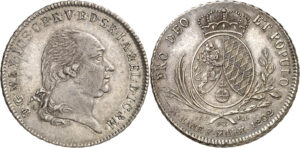
There is no other specimen of the konventionsthaler of 1802 that is of comparable quality. Collectors and investors rewarded the coin’s outstanding condition with the impressive hammer price of 62,000 euros. This made the konventionsthaler struck in 1802 by Maximilian IV Joseph, who had been Duke of Bavaria and Count Palatine of the Rhine since 1799, the most expensive piece of the collection and of the entire auction sale. This is another example for the crucial role a coin’s quality plays today.
All coins offered in this auction were of outstanding quality, many had a fine patina and all of them were well struck – they embodied what Heidelberger Münzhandlung is specialized in. If you are looking for small coins, talers or coins of the German Empire of excellent quality, Herbert Grün is the place to go, regardless of whether you want to buy or sell.
Heidelberger Münzhandlung is always looking for issues of high quality. You can contact Herbert Grün at the following address: Heidelberger Münzhandlung Herbert Grün, Gaisbergstr. 40, 69115 Heidelberg, Germany; phone: +49 / 6221 / 65 2970; fax: +49 / 6221 / 65 297-29; email.
On Sixbid you can find all results of auction 80 and auction 79.





